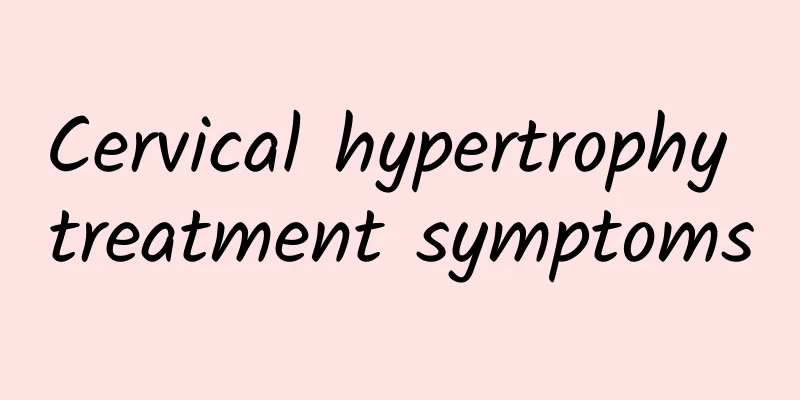Cervical hypertrophy treatment symptoms

|
The treatment of cervical hypertrophy needs to be targeted according to the symptoms and causes. Common methods include drug therapy, physical therapy and surgical treatment. Cervical hypertrophy is usually caused by chronic cervicitis, abnormal hormone levels or birth injuries, and manifests as increased vaginal discharge, lower abdominal pain or bleeding during sexual intercourse. 1. Drug treatment is suitable for cervical hypertrophy caused by inflammation. Commonly used drugs include antibiotics, anti-inflammatory drugs and topical drugs. Antibiotics such as metronidazole and levofloxacin can inhibit bacterial infection, glucocorticoid drugs can help reduce inflammatory reactions, and topical preparations such as clotrimazole suppositories can relieve local discomfort. 2 Physical therapy reduces the size of the cervix through laser, freezing or microwave. Laser therapy uses high-energy beams to vaporize diseased tissue, cryotherapy uses liquid nitrogen freezing technology to eliminate abnormal proliferation, and microwave therapy promotes tissue repair through the thermal effect of electromagnetic waves. 3Surgical treatment is for severe cases of cervical hypertrophy, including cervical conization, loop electrosurgical excision and hysterectomy. Cervical conization removes part of the cervical tissue for pathological examination, loop electrosurgical excision uses an electric knife to cut the lesion, and hysterectomy is suitable for cases with other gynecological diseases. Daily care can help relieve symptoms and prevent recurrence. Keep the vulva clean and dry, avoid using irritating lotions; wear cotton breathable underwear and change it regularly; do appropriate exercise to enhance immunity, such as yoga and brisk walking; eat a balanced diet and eat more foods rich in vitamins and protein. Symptoms of cervical hypertrophy are often accompanied by discomfort, and timely medical examination and treatment are required. Through standardized treatment plans and good living habits, most patients can achieve satisfactory results and reduce complications. Regular gynecological examinations can help detect and treat cervical diseases early and maintain women's reproductive health. |
<<: What tests are done to diagnose the cause of sinus atresia?
>>: What are the symptoms of hydatidiform mole
Recommend
Some precautions for the use of medications for vaginitis
Many female friends rarely go to the hospital for...
Complications of bacterial vaginosis Various treatments for vaginitis
Vaginitis is one of the diseases that troubles ma...
Menopausal women can take wolfberry lotus heart tea regularly to regulate menstruation
Menopausal women often experience irregular menst...
How to avoid pelvic peritonitis
How to avoid pelvic peritonitis? There are many f...
Is it normal for the right ovarian cyst to be echoless? Are there many symptoms?
Is it normal for a right ovarian cyst to be echol...
Jiang Gui Liang Jiang Congee is suitable for patients with dysmenorrhea caused by cold stagnation and qi stagnation
Cold stagnation and qi stagnation is a common typ...
Symptoms of Uterine Fibroids Causing Abnormal Vaginal Discharge
Everyone knows that the earlier the symptoms of u...
Stay away from the three highs by supplementing deep sea magnesium (Part 1)
Magnesium is one of the essential minerals for th...
Which hospital is better for treating endometrial tuberculosis?
Recently, more and more female friends have been ...
Not gaining weight during menstruation? Smart way to develop a body that is easy to lose weight! Traditional Chinese Medicine: Master the two golden periods of weight loss to lose weight effectively
Many girls often try to lose weight, but not nece...
Should I remove my ovaries for an ectopic pregnancy?
Whether ectopic pregnancy requires ovarian remova...
Is the success rate of premature ovarian failure high?
Is the success rate of premature ovarian failure ...
Consequences of severe cervical erosion
The incidence rate of women with cervical erosion...
Is lymphatic drainage effective? Can lymphatic massage help you lose weight? Lymphedema therapists debunk 3 myths
Lymphedema has been classified as a new chronic d...
To lose weight, adopt a low-carb diet and eat less starch? Nutritionists teach you 4 tips on eating the right starch to lose weight
People who want to lose weight often try a "...







![[Video version] Potatoes VS sweet potatoes, a big PK in weight loss! The winner is...](/upload/images/67dcf7f7d93d2.webp)

